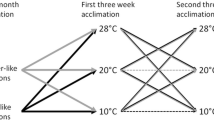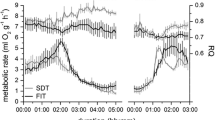Abstract
Djungarian hamsters (Phodopus sungorus) tolerate short-term exposure to ambient temperatures (T as) down to −70°C, but surprisingly, previously appeared to reach maximum sustainable metabolic rate (SusMR) when kept at T as as high as ≥−2°C. We hypothesized that SusMR in Djungarian hamsters may be affected by the degree of prior cold acclimation and temporal patterns of T a changes experienced by the animals, as average T a declines. After cold-acclimation at +5°C for 6 weeks, hamsters reached rates of SusMR that were 35% higher than previously determined and were able to maintain positive energy balances down to T a −9°C. SusMR was unaffected, however, by whether mean cold load was constant or caused by T as cycling between +3°C and as low as −25°C, at hourly intervals. At mean T as between +3 and −3°C hamsters significantly reduced body mass and energy expenditure, but were able to maintain stable body mass at lower T as (−5 to −9°C). These results indicate that prior cold-acclimation profoundly affects SusMR in hamsters and that body mass regulation may play an integral part in maintaining positive energy balance during cold exposure. Because the degree of instantaneous cold load had no effect on SusMR, we hypothesize that limits to energy turnover in Djungarian hamsters are not determined by the capacity to withstand extreme temperatures (i.e., peripheral limits) but are due to central limitation of energy intake.





Similar content being viewed by others
References
Blaxter K (1989) Energy metabolism in animals and man. Cambridge University Press, Cambridge
Bronson FH (1987) Susceptibility of the fat reserves of mice to natural challenges. J Comp Physiol B 157:551–554
Dekinga A, Dietz MW, Koolhaas A, Piersma T (2001) Time course and reversibility of changes in the gizzards of red knots alternately eating hard and soft food. J Exp Biol 204:2167–2173
Drent RH, Daan S (1980) The prudent parent: energetic adjustments in avian breeding. Ardea 86:225–252
Forbes JM (2007) Reproduction and lactation. In: Forbes JM (ed) Voluntary food intake and diet selection in farm animals, 2nd edn. Cab International, London, pp 341–364
Gross JE, Wang Z, Wunder B (1985) Effects of food quality and energy needs: changes in gut morphology and capacity of Microtus ochrogaster. J Mammal 66:661–667
Hammond KA, Diamond J (1997) Maximal sustained energy budgets in humans and animals. Nature 386:457–462
Hammond K, Wunder BA (1995) Effect of cold temperatures on the morphology of gastrointestinal tracts of two microtine rodents. J Mammal 76:232–239
Hammond KA, Konarzewski M, Torres R, Diamond J (1994) Metabolic ceilings under a combination of peak energy demands. Physiol Zool 67:1479–1506
Hammond KA, Lloyd K, Diamond J (1996) Is mammary output capacity limiting to lactational performance in mice? J Exp Biol 199:337–349
Heldmaier G (1989) Seasonal acclimatization of energy requirements in mammals: functional significance of body weight control, hypothermia, torpor and hibernation. In: Gnaiger E, Wieser W (eds) Energy transformations in cells and organisms. Thieme Verlag, Stuttgart, pp 130–139
Heldmaier G, Steinlechner S (1981) Seasonal control of energy requirements for thermoregulation in the Djungarian hamster (Phodopus sungorus), living in natural photoperiod. J Comp Physiol 142:429–437
Heldmaier G, Steinlechner S, Rafael J (1982) Nonshivering thermogenesis and cold resistance during seasonal acclimatization in the Djungarian hamster. J Comp Physiol B 149:1–9
Heldmaier G, Böckler H, Buchberger A, Lynch GR, Puchalski W, Steinlechner S, Wiesinger H (1985) Seasonal acclimation and thermogenesis. In: Gilles R (ed) Circulation, respiration, and metabolism. Springer, Berlin
Heldmaier G, Steinlechner S, Ruf T, Wiesinger H, Klingenspor M (1989) Photoperiod and thermoregulation in vertebrates: body temperature rhythms and thermogenic acclimation. J Biol Rhythms 4:251–265
Hothorn T, Bretz F, Westfall P (2008) Simultaneous inference in general parametric models. Biom J 50:346–363
Koteja P (1996a) Limits to the energy budget in a rodent, Peromyscus maniculatus: the central limitation hypothesis. Physiol Zool 69:981–993
Koteja P (1996b) Limits to the energy budget in a rodent, Peromyscus maniculatus: does gut capacity set the limit? Physiol Zool 69:994–1020
Krol E, Murphy M, Speakman JR (2007) Limits to sustained energy intake X. Effects of fur removal on reproductive performance in laboratory mice. J Exp Biol 210:4233–4243
Landis CA, Bergmann BM, Ismail MM, Rechtschaffen A (1992) Sleep deprivation in the rat: XV. Ambient temperature choice in paradoxical sleep-deprived rats. Sleep 15(1):13–20
Lovegrove BG (2005) Seasonal thermoregulatory responses in mammals. J Comp Physiol B 175:231–247
McDevitt RM, Speakman JR (1994) Central limits to sustainable metabolic rate have no role in cold acclimation of the short-tailed field vole (Microtus agrestis). Physiol Zool 67:1117–1139
Obermeyer W, Bergmann BM, Rechtschaffen A (1991) Sleep deprivation in the rat: XIV. Comparison of waking hypothalamic and peritoneal temperatures. Sleep 14(4):285–293
Peterson CC, Nagy KA, Diamond J (1990) Sustained metabolic scope. Proc Natl Acad Sci USA 87:2324–2328
Piersma T, Drent J (2003) Phenotypic flexibility and the evolution of organismal design. TREE 18:228–233
Pinheiro J, Bates D, DebRoy S, Sarkar D, the R Core team (2009) nlme: linear and nonlinear mixed effects models. R package version 3.1-93
Rafael J, Vsiansky P, Heldmaier G (1985) Increased contribution of brown adipose tissue to nonshivering thermogenesis in the Djungarian hamster during cold-adaptation. J Comp Physiol B 155:717–722
R Development Core Team (2009) R: a language and environment for statistical computing. R Foundation for Statistical Computing, Vienna, Austria. http://www.R-project.org. ISBN 3-900051-07-0
Rechtschaffen A, Bergmann BM, Everson CA, Kushida CA, Gilliland MA (1989) Sleep deprivation in the rat: X. Integration and discussion of the findings. Sleep 25(1):68
Ruf T, Heldmaier G (2000) Djungarian hamsters-small graminivores with daily torpor. In: Halle S, Stenseth N (eds) Activity patterns in small mammals. Springer, Berlin
Speakman JR (2008) The physiological costs of reproduction in small mammals. Philos Trans R Soc B 363:375–398
Speakman JR, Krol E (2005) Limits to sustained energy intake IX: a review of hypotheses. J Comp Physiol B 175:375–394
Steinlechner S, Heldmaier G, Becker H (1983) The seasonal cycle of body weight in the Djungarian hamster: photoperiodic control and the influence of starvation and melatonin. Oecologia 60:401–405
Swanson DL (2001) Are summit metabolism and thermogenic endurance correlated in winter-acclimatized passerine birds? J Comp Physiol B 171:475–481
Valencak TG, Tataruch F, Ruf T (2009) Peak energy turnover in lactating European hares: the role of fat reserves. J Exp Biol 212:231–237
Weiner J (1987) Maximum energy assimilation rates in the Djungarian hamster (Phodopus sungorus). Oecologia 72:297–302
Weiner J (1992) Physiological limits to sustainable energy budgets in birds and mammals: ecological implications. TREE 7:384–388
Withers PC (2001) Design, calibration and calculation for flow-through respirometry systems. Aust J Zool 49:445–461
Wynne-Edwards K (1998) Evolution of parental care in Phodopus: conflict between adaptations for survival and adaptations for rapid reproduction. Am Zool 38:238–250
Zynel CA, Wunder BA (2002) Limits to food intake by the Prairie Vole: effects of time for digestion. Funct Ecol 16:58–66
Acknowledgments
Thanks to Elisabeth Buchinger, Michaela Salaba, and Peter Steiger for their help with animal maintenance. We also thank two anonymous reviewers for helpful comments. All experiments described here were approved by the Vienna University of Veterinary Medicine ethics committee and comply with the current laws in Austria, where the experiments were performed.
Author information
Authors and Affiliations
Corresponding author
Additional information
Communicated by G. Heldmaier.
Rights and permissions
About this article
Cite this article
Ruf, T., Grafl, B. Maximum rates of sustained metabolic rate in cold-exposed Djungarian hamsters (Phodopus sungorus): the second wind. J Comp Physiol B 180, 1089–1098 (2010). https://doi.org/10.1007/s00360-010-0476-8
Received:
Revised:
Accepted:
Published:
Issue Date:
DOI: https://doi.org/10.1007/s00360-010-0476-8




